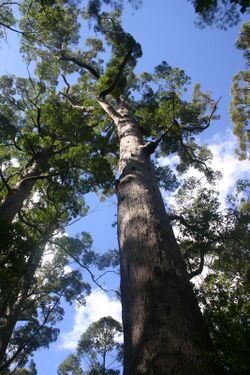Biology:Bertmainius tingle
| Bertmainius tingle | |
|---|---|
| Scientific classification | |
| Domain: | Eukaryota |
| Kingdom: | Animalia |
| Phylum: | Arthropoda |
| Subphylum: | Chelicerata |
| Class: | Arachnida |
| Order: | Araneae |
| Infraorder: | Mygalomorphae |
| Family: | Migidae |
| Genus: | Bertmainius |
| Species: | B. tingle
|
| Binomial name | |
| Bertmainius tingle (Main, 1991)[1]
| |
| Synonyms | |
|
Moggridgea tingle Main, 1991 | |
Bertmainius tingle, also called the tingle trapdoor spider, is a small basal spider endemic to the tingle and karri forest of southwestern Western Australia. This migid family species of Bertmainius was first recorded in the 1990s.
Description
Bertmainius tingle is less than 10 millimetres long, the female carapace length is 2.6 - 3.1 mm. The carapace and legs are black and shiny. Western Australian species of the family Migidae remained undiscovered until 1990 and were first described and named in the genus Moggridgea by Dr Barbara Main in 1991. B. tingle was discovered by accident in a laboratory analysis of another arachnid and the bark in which it was living, the spider was noticed when it emerged as the sample was discarded.[2] The specific epithet is derived from the common name "tingle", the tree from which the bark was taken.[citation needed]
It was moved to the new genus Bertmainius by Mark Harvey and colleagues in 2015, based on significant differences in morphology and molecular data.
Distribution
The species is found at two sites in the Walpole-Nornalup National Park residing in the soil or the bark of the red tingle (Eucalyptus jacksonii). The spider's habitat is located within the tingle and karri (Eucalyptus diversicolor) forests of the Warren bioregion, a biodiversity hotspot containing other species of gondwanan heritage. Other species of Bertmainius have since been described from south-western Australia.
Ecology
Bertmainius tingle live within the topsoil or in the fibrous bark of the red tingle, constructing nests of silk tubes. These tubes, up 20 mm long, have an opening at the surface of the bark or soil with a hinged 'trapdoor' cover made of moss, bark and the spider's silk. It is found in damp and shady locations.
Bertmainius tingle is vulnerable to fire and habitat destruction associated with roads. Planning exists to reduce damage to the species habitat during fire management operations such as 'prescribed burns'. It has a status of endangered due to destruction of habitat.[citation needed]
References
- ↑ Main, B.Y. 1991. Occurrence of the trapdoor spider genus Moggridgea in Australia with descriptions of two new species (Araneae: Mygalomorphae: Migidae). Journal of Natural History 25: 383–397 [385].
- ↑ Madden, Catherine. "Rare spider found near Walpole". ScienceNetwork WA. Government of Western Australia. http://www.sciencewa.net.au/index.php?option=com_content&task=view&id=655&Itemid=587. Retrieved 2009-03-01.
- Burbidge, Andrew A (2004). "9. Invertebrates". Threatened animals of Western Australia. Department of Conservation and Land Management. pp. 160. ISBN 0-7307-5549-5. "The Department of Conservation and Land Management has developed a fire response plan to ensure that the spider's habitat is not damaged by fire-fighting operations."
- Main, Barbara (1991). "Occurrence of the trapdoor spider genus Moggridgea in Australia with descriptions of two new species (Araneae: Mygalomorphae: Migidae)". Journal of Natural History 25 (25): 383–397. doi:10.1080/00222939100770271. ISSN 0022-2933. http://taylorandfrancis.metapress.com/content/w0242499638n5h47/. Retrieved 1 April 2007. "Abstract: The occurrence of the trapdoor spider genus Moggridgea (Migidae) in Australia is reported, and two new species described: M. tingle n. sp. from southwest Western Australia and M. australis n. sp. from Kangaroo Island, South Australia. This is the first record of the subfamily Paramiginae from Australia. The historical biogeographic implications are discussed.".
- "'Moggridgea tingle Main, 1991". Australian Faunal Directory. Canberra: Department of the Environment and Energy. 9 October 2008. http://www.environment.gov.au/biodiversity/abrs/online-resources/fauna/afd/taxa/Moggridgea_tingle.
- "1. Common Names: tingle trapdoor spider, Moggridea tingle Main". CES.CSIRO.au. Commonwealth Scientific and Industrial Research Organisation. 18 September 2004. http://www.ces.csiro.au/aicn/name_c/a_4328.htm.
- Waldock, Julianne M. (December 2004). "Migidae in south-western West Australia (Araneae, Mygalomorphae)". Australasian Arachnology (Welshpool, W. Australia: Australasian Arachnological Society) (70): 5–6. ISSN 0811-3696. http://www.australasian-arachnology.org/download/newsletter/newsletter70.pdf. Retrieved 10 December 2017.
- Framenau, Volker W. (12 July 2017). "Checklist of Australasian Spiders". Christchurch, New Zealand: Australasian Arachnological Society. p. 93. http://www.australasian-arachnology.org/download/checklist_australian_spiders.pdf.
- Danks, Alan (March 2004). "South Coast Biodiversity: An Overview of Biodiversity Values, Threats and Conservation in the South Coast Region". Albany, W. Australia: Department of Conservation and Land Management. pp. 11, 21. http://www.southernnrmcouncil.com/documents/publications/strategy/background/Background_Paper_02_Biodiversity.pdf.
- "Spider find may spark forest management rethink". ABC News (Australian Broadcasting Corporation). 8 March 2007. http://www.abc.net.au/news/2007-03-09/spider-find-may-spark-forest-management-rethink/2212566.
- Bennett, Michael (8 March 2007). "Ancient spider discovered in South-West". The West Australian (Vivid Group). http://www.thewest.com.au/default.aspx?MenuID=146&ContentID=23033.
Wikidata ☰ Q27502905 entry
 |


